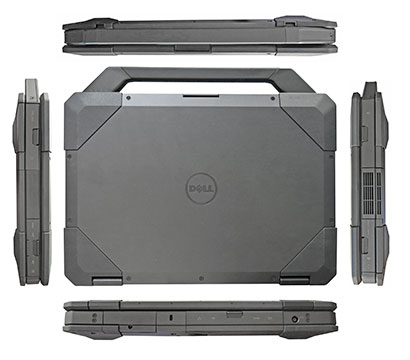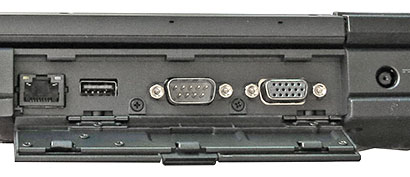|
Dell Latitude 14 Rugged
Dell's new full-size, semi-rugged notebook computer
(by Conrad H. Blickenstorfer)
On September 4, 2014, Dell introduced the Latitude 14 Rugged. It is a semi-rugged notebook computer and the successor of the Dell Latitude 6430 ATG (see here), which was a fortified and toughened-up version of Dell's consumer and enterprise line of Latitude E6430 computers, and a very good one at that. What did Dell as a follow-up, and how did they go about it?

First, let's recap where the new Latitude 14 Rugged fits in. For several years Dell was offering "ATG" ("All Terrain Grade") semi-rugged and "XFR" (Xtreme Fully Rugged") rugged notebooks. The XFR models were originally made for Dell by Augmentix, which later became part of Dell. In early 2014, Dell replaced the XFR with the Latitude 12 Rugged Extreme convertible and the Latitude 14 Rugged Extreme laptop. The new Latitude 14 Rugged replaces the ATG. So going forward, Dell offers semi-rugged "Latitude Rugged" and fully-rugged "Latitude Rugged Extreme" models.
One point Dell emphasizes is that whereas the predecessor ATG models were built "up" from standard Latitude commercial versions, the new 14 Rugged is built "down" from the Rugged Extreme line. An informally given analogy by a Dell rep was that the new 14 Rugged is like a SUV built on a truck platform whereas the ATGs were SUVs built on car platforms. And, indeed, the new all-black Rugged 14 with its hefty carry handle looks considerably tougher and more businesslike than the old ATG. That said, we really liked the ATG 6430 we did a full review on in August 2013 (see here). So what is the Dell Latitude 14 Rugged, and what does it do better?
It is a Dell laptop that's substantially tougher and more durable than a standard Latitude. It measures 13.7 x 9.6 inches, is 1.73 inches thick, and weighs 6.6 pounds. That's a good bit more than a civilian Latitude E6440's 4.7 pounds, but actually a bit less than our last test E6430 ATG. Right off the bat, one thing that's changed for the better is the new handle. It's sturdier and much better integrated. Another is the battery. We did not much care for the ATG's netbook-style battery that slid into the back of the machine. In the new 14 Rugged, the battery glides into the side of the computer, as it should. We weren't crazy about the ATG's wimpy protective doors for the ports, and that, too, has changed for the better. The 14 Rugged has much beefier doors.

On the processor side, the Latitude 14 Rugged is now based on ultra-low voltage versions of Intel's "Haswell" 4th generation Core processors, with maximum thermal design power of 15 watts as compared to the 35 and even 45 watt TDP 3rd gen Core chips of the predecessor ATG's processors. At the same time, the standard battery's capacity was raised from 60 watt-hours to 65 watt-hours and there's still the optional 97 watt-hour battery. Dell claims up to 14 hours run-time with the extended battery. Given that even the ATG we tested was exceptionally power-efficient, the claim seems reasonable.
Display and interface
The new rugged Dell has an 14-inch display with 1366 x 768 pixel resolution. That's a good chunk of screen real estate, without being too big. The resolution is the same as that of both the 12 and the 14 Rugged Extreme. We wish there were a higher res option for applications that benefit from it, such as mapping and GIS, especially since Dell does offer a optional discrete Nvidia GeForce GT 720M graphics card (see here for details on the card). Most of Dell's civilian Latitude E6440s come with a 1600 x 900 pixel display, and we'd like to see that available for the rugged machine as well.
Dell is one of the pioneers in modern-era outdoor-viewable displays, and the Rugged 14 benefits from that expertise. Dell's screen technology reduces internal reflectivity and display glare to the extent where the device doesn't need a battery-killing superbright backlight to achieve good viewing performance outdoors and in the sun. However, the 14 Extreme doesn't have an IPS screen, and there are some color shifts when viewing it from certain vertical angles.
Like most new notebooks that can run Windows 8.1, the Latitude 14 Rugged has a touchscreen. Dell chose resistive over capacitive multi-touch on the grounds that resistive technology works better with gloves and in wet conditions.
Extensive connectivity
Like the competition in this class, the Latitude 14 Rugged offers excellent connectivity and expandability. There are two USB 3.0 ports, two USB 2.0 ports, two native RS232 serial port, two gigabit RJ45 LAN jacks, audio in/out, VGA and HDMI video, and a docking connector (that's optional since not everyone needs it), all with protective covers. There is a memory card reader and an Expresscard/54 or PC Card slot as well.
Below is a close-up of the backside of the 14 Rugged with the protective door open. There are I/O compartments on the left and right side as well, and each has a protective cover. These covers are not meant to be waterproof, but they securely snap into place, and can easily be replaced should they ever break or wear out.

State-of-the-art wireless communication is crucial in a mobile computing device, be that in the office or out there on the road or in the field. Dell covers that with a Dell Wireless 1701 802.11n module that also includes Bluetooth 4.0LE. Optional mobile broadband is available via a Dell Wireless 5808E Gobi 5000 4G LTE module that includes A-GPS.
Semi-rugged design
How tough and rugged is Dell's replacement for the 6430 ATG? Considerably more so than a standard notebook, and — more importantly — also more rugged than the old 6430 ATG. Drops from a desk or coffee spilled onto the keyboard won't faze the 14 Rugged whereas they can kill a lesser laptop. The drop spec is now three feet instead of two and a half. And while semi-ruggeds generally aren't sealed, the 14 Rugged does carry an IP52 rating, where the "5" means the device is protected against dust, and the "2" that it's also protected against direct sprays of water at up to 15 degree angles from vertical. That means it can handle not only the accidental spill but also rain (the ATG 6430 only had an IP5x rating, meaning it didn't claim any IP protection against liquids).
An important requirement of semi-ruggeds is that they continue to perform when it's very hot or very cold. The ATG 6430 specs didn't list a specific operating temperature range, but the 14 Rugged's does: -20° to 140° Fahrenheit. That's impressive, and Dell reps say the machine can maintain full performance over the entire range.
Performance: Intel 4th gen Core processors
What about performance? That comes via your choice of Intel i3, i5 or i7 4th generation Core processors. Codenamed "Haswell," the 4th gen offers significant enhancements in power conservation and improved graphics performance. All three of the available CPUs are ultra-low voltage versions with TDPs of just 15 watts. The high-end i7 processor has integrated HD Graphics 5000 with 40 execution units versus 20 for the HD Graphics in the other two chips, likely making for significantly higher graphics performance.
|
Available 14 Rugged CPUs
|
Intel Core i7
|
Intel Core i5
|
Intel Core i3
|
|
Model
|
4650U
|
4310U
|
4030U
|
|
Cores/Threads
|
2/4
|
2/4
|
2/4
|
|
Base Clock Speed
|
1.70 GHz
|
2.00 GHz
|
1.90 GHz
|
|
Turbo Speed
|
3.30 GHz
|
3.00 GHz
|
No turbo
|
|
Thermal Design Power (TDP)
|
15 watts
|
15 watts
|
15 watts
|
|
Smart Cache
|
4MB
|
4MB
|
4MB
|
|
Integrated graphics
|
HD Graphics 5000 (40 EUs)
|
HD Graphics 4400 (20 EUs)
|
HD Graphics 4400 (20 EUs)
|
|
Graphics base speed
|
200 MHz
|
200 MHz
|
200 MHz
|
|
Graphics max speed
|
1.10 GHz
|
1.10 GHz
|
1.00 GHz
|
|
Intel vPro
|
Yes
|
Yes
|
No
|
To see full spec table for these three CPUs, see here.
The device supports up to 16GB of DDR3L memory in two slots. Mass storage is via mSATA solid state disks up to 256GB. An SED version (Self-Encrypting Drive) is optionally available. The 14 Rugged comes with either a Li-Ion battery capacity of either 65 watt-hours or 97 watt-hours, the latter good for up to 14 hours (which may be conservative, given the miserly Haswell CPUs).
Keyboard: Full scale and RGB backlight
The full-size keyboard of the Latitude 14 Rugged has a crisp and clean layout with well designed labels. A special RGB backlight allows users to set the keyboard backlight to any color they wish. That can come in very handy.
Security
For security, the Dell Latitude 14 has FIPS 140-2 TPM 1.2 functionality to store secured information. Smart Card reader and optional fingerprint reader provide additional access security. There's a cable lock slot, some of the available processors support vPro, a set of Intel security and remote management technologies that offer multiple lines of built-in defenses, and there are also Dell's advanced security and data protection and encryption tools.
What Dell brings to the table
The big difference between Dell and its competition in the rugged space is that Dell is also a world-leading provider of commercial PCs, which gives them an edge in large scale production experience and also with enterprises that like to one-stop shop.
As good as the ATG 6430 was, existing Dell ATG customers will find in the Latitude 14 Rugged a machine that is more rugged, better protected, and probably offers longer battery life. It's also fully compatible with any Rugged Extreme docks and mounting solutions, and customers have a vast array of options available to configure the machine exactly to their requirements.
Between that, Dell's renewed and expanded commitment to the rugged space, and the machine's impressive design, up-to-date technology and specs, this new semi-rugged notebook is certain to be a strong competitor.
|



